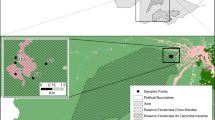Abstract
Studies on the distribution and bionomy of bats settled in nest boxes in the forests of Geisenfeld, Upper Bavaria
In spring, summer and autumn of 1976 a number of 608 nest boxes constructed as well for birds (554) as for bats (54) hanging in four different wood areas of the Geisenfeld forest was investigated. Two species of bats were found only, the Great Bat,Nyctalus noctula Schreb. (6 Indiv.) and the Long-eared Bat,Plecotus auritus L. (64 Indiv.). The highest number of settlements showed the Thüring bow box with 19%, followed by the Bavarian gable box with 10%. The bats did'nt prefer boxes with horizontal slit, constructed especially for them. By help of a leg hoop fixed in 1959, the age of a femaleP. auritus was stated to 17 years. Both of bat species showed highest trueness to selected locations as to be seen from comparison between former and new results. In deciduous woods no bat was found in the boxes. Here they probable preferred natural holes of old oaks. In deeply (at eye-level) hanging boxes the bats were absent, probable in consequence of disturbing by men. The females and males ofP. auritus were in the ratio of 49 : 11. The highest numbers of females fertilized and aggregated for maternity were 12, 7, 6, 4, and 4 respectively. The average number of bats per check amounted to 23, this resulted in a density of 1 bat per 13 ha. The causes of this low density are to be seen in the low propagation of the bats and particularly in the lack of overwintering holes.
Similar content being viewed by others
Literaturverzeichnis
Bels, L., 1952: Publicaties van het Natuurh. Genootschap in Limburg 1952.
Eisentraut, M., 1937: Die deutschen Fledermäuse. Verlag Schöps, Leipzig 1937.
Henze, O., 1963: Hilfe für Waldfledermäuse. Allg. Forstzeitschr.18, 437–440.
Henze, O., 1976: Möglichkeiten erfolgreichen Fledermausschutzes. Allg. Forstzeitschr.31, 448–450.
Issel, B.;Issel, W., 1955: Versuche zur Aussiedlung von „ Waldfledermäusen” in Fledermauskästen. Forstw. Cbl.74, (7/8), 193–204.
Kolb, A., 1957: Fledermäuse im Wald. Allg. Forstzeitschr.12, 152.
Krzanowski, A., 1959: Ergebnisse des Waldfledermausschutzes auf Grund fremder und eigener Erfahrungen. Waldhygiene3, 99–105.
Natuschke, G., 1960: Heimische Fledermäuse, Neue Brehm-Bücherei, Heft 269. Wittenberg-Lutherstadt 1960.
Ryberg, O., 1947: Studies on bats and bat parasites. Bokförlaget Svensk Natur, Stokholm 1947.
Author information
Authors and Affiliations
Rights and permissions
About this article
Cite this article
Luger, F. Untersuchungen zur Verbreitung und Lebensweise von Fledermäusen in Nistkästen im Geisenfelder Forst, Oberbayern. Anz. Schadlingskde., Pflanzenschutz, Umweltschutz 50, 183–188 (1977). https://doi.org/10.1007/BF02156727
Issue Date:
DOI: https://doi.org/10.1007/BF02156727



